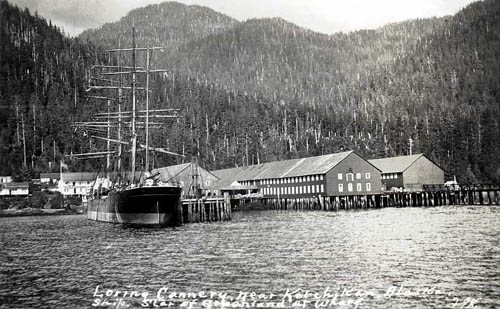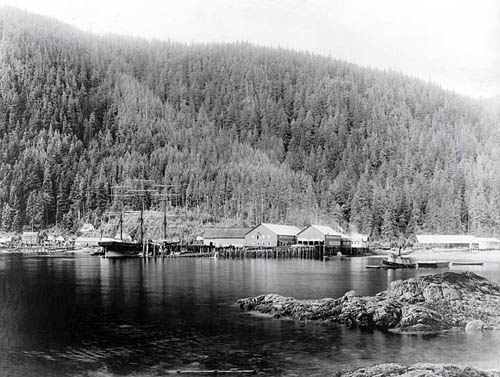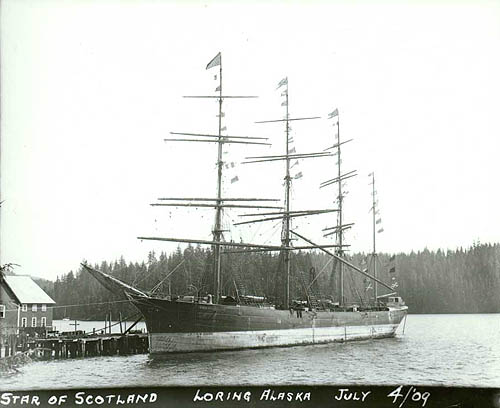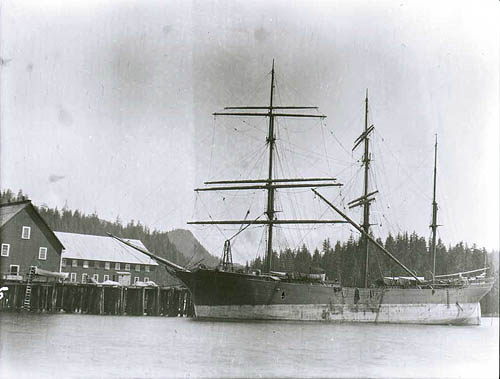 By June Allen September 14, 2002
 Photographer: Forest J. Hunt Donor: John T. Wynne Courtesy of the Ketchikan Museums, Tongass Historical Society Collection Loring is located on Naha Bay 25 miles to the north, some two hours away by boat or 40 minutes or so by floatplane. No one knows for sure why the place was named Loring. Unless it is a mispronunciation of an Indian name, it may have been named by the saltery's manager, Max Pracht. A hand-lettered sign on its dock stated that Loring was established in 1875. It was first a small Indian settlement - maybe a fish camp, then a saltery and later a much larger cannery town with upward of 40 houses, not counting the seasonal workers' temporary dwellings during the canning season. It is all but a ghost town now, just a few houses hugging the shoreline, a few with summer or occasional occupants. In the years after the Loring cannery's closure in 1930, the cannery's extensive cluster of large buildings began to disappear, board by board, and boatload by boatload. There are those among the residents of Ketchikan's north end of town who openly and proudly attest to pieces of Loring's cannery history nailed into structures on their own property. But if Loring is a ghost town now, it is populated by scores of cheerfully contented ghosts to be appreciated by those imaginative visitors who know Loring's story. Loring's residents in those early years included busy Tsimshian and white cannery employees and their wives living in little houses along the beach. A few cannery families were year-round employees. Just down the trail toward the cannery were the quarters of the cannery's Chinese crews, while beyond that, along the shallow creek, were the tents and simple shacks of the Filipino workers. They were the seasonal help. Across the shallow creek and up a slight climb there is Loring's old graveyard, home to today's only "permanent" residents. A few are the seamen who were killed in accidents aboard the big ships of the cannery days. There were, and maybe still are, the remains of Indian graves there - miniature grave houses and fences. As small a town as it was, there were times in Loring of great excitement! In August of 1889 the southbound side-paddle steamer Ancon called with freight and mail, plus tourists. The ship was then loaded with 14,000 cases of Loring's canned salmon for the trip south. At departure, however, someone cast the lines off too soon in the strong winds and the ship couldn't be prevented from drifting onto a shoal. Her hull was punctured and her back broken. Workers removed the cases of salmon, and the rescued passengers were forced to stay in Loring for a week until another southbound ship could carry them south.  Donor: Lo Ann Swanson Courtesy of the Ketchikan Museums, Tongass Historical Society Collection Shipwrecks were not uncommon in Alaska waters and the wreck of the Ancon was not particularly dramatic. It would probably been forgotten in time. But among those stranded passengers was a famous painter of the time, a German-American artist named Albert Bierstadt, known for his large paintings of the American west. He quickly sketched the listing vessel for the painting he would title, simply, "The Wreck of the Ancon." It hangs today in the Museum of Fine Arts in Boston. The submerged Ancon remains in the minds of visitors too - its rusted boilers can be seen to this day at low tides. After the Alaska Packers bought the Loring cannery in the 1890s, the arrival of one of the Packers' beautiful sailing ships was always a time of excitement for the town. Alaska Packers Association was known as a "very frugal" cannery association. The ships of the company's "Star" fleet, derisively called windjammers by steamship sailors, were spacious, fast and sleek, beautiful, and comparatively inexpensive to operate. They required no coal or oil for steam - their billowing sails were driven by the winds of the Pacific Ocean. In the spring, the northbound ships were towed out of their winter quarters at Alameda in San Francisco Bay to the open ocean where they caught the winds; each season they traveled as far north as Bristol Bay to deliver supplies and workers to their various cannery locations. En route south again, they stopped in the outside waters and were towed into cannery locations, including Loring, to carry the canned product south to market. So the ships weren't under sail when they arrived, but still they were exciting for the people of Loring. And the crews were welcomed ashore, many of the sailors as old friends. In the early years, each spring the ships brought Chinese work gangs from their hiring hall in San Francisco. The fish processing machine that has now replaced part of their work is called the Iron Chink. It beheads, splits and guts the fish one by one. 'Tween-deck quarters in the ship were provided for the Chinese men, their chickens, pigs, sacks of rice, vegetable seeds, dishes and utensils - and of course their contraband ceramic jars of rice wine. At a cannery destination, the company provided a "china house," a building with bunks and a stove. The Chinese penned their animals and cleared garden patches both for soil and sun and planted their seeds. From these vegetables, their pigs and chickens, all the fish they could eat, and the rice, they fed themselves for the season, not being paid until the end of the season. The Loring china house and separate quarters were up the hill behind the cannery itself. These living conditions sound inhuman today, but in those years they were standard, and there was little or no resistance from the workmen themselves, who felt they lived well enough while employed, and who made enough money to support their families in China in relative comfort. But by the early 1920s, the nation was undergoing a period of fear about the limits of immigration itself and about what was called "the yellow peril" of indentured Asian workers in the country. At that time the canneries began to use others to do the work once done by the Chinese.  Photographer: Cornelius Giebel Donor: Disie Baade Courtesy of the Ketchikan Museums, Tongass Historical Society Collection A story in the Ketchikan Chronicle of August 6, 1923, tells another tale of excitement in Loring. A fight between a Mexican cook and a fellow countryman waiter erupted into a free-for-all in which two of the combatants ended in the Ketchikan General Hospital and one in Ketchikan's City jail. The weapons of choice were meat cleavers, 12-inch butcher knives and iron bars. From the news article, it seems that a nervous waiter, fearing a Prohibition "revenue man" was going to discover a secret cache of hootch being made from a mixture of sourdough and fruit, overturned the brew's container in panic. An angry cook then burst in with meat chopper in hand to let the waiter know his displeasure with the clumsiness and the bloody battle began. Little else was reported in the Ketchikan newspaper because the combatants knew little or no English - and the police questioners were equally disadvantaged. The hospitalized men recovered nicely and there was no mention of what happened to the man in jail. It's unlikely the people of Loring heard the battle, but they certainly must have been talking about all the excitement! The houses in Loring, the town itself, were a little distance from the cannery but connected by boardwalks. The houses were, and still are, connected to each other by boardwalks and stairsteps where needed, the wet boards bordered with wildflowers and encroaching berry bush tendrils. The forest has been creeping back into the townsite for years. But there are at least two trees that are quite special - balsam poplar that are called Balm of Gilead trees. An early resident named George Collins brought back to Loring a number of saplings of those special trees from along the Unuk River on the mainland. Huge now, the trees' fragrant summer blossoms attract thousands of hummingbirds each June. Loring in summer is alive with birds and berries and flowers. During those summer months a century ago Loring smelled of salt water, the cannery and fish offal and smokehouses, and with the tang of berries boiling for jelly and, in the case of the bachelors' houses, elderberries - called "laughing berries" - for wine. In the neighborhood were blueberries and salal berries, huckleberries, wild currants, cranberries and crab apple for putting up for the winter. Highbush cranberries were mixed with ooligan grease, stored in wooden buckets and in the winter put out on the snow and eaten like ice cream.  Photographer: Cornelius Giebel Donor: Dixie Baade Courtesy of the Ketchikan Museums, Tongass Historical Society Collection Loring is ear-ringing silent now, but back then there were flocks of children in the little town and more crying babies being born every year. With working and busy parents, the older children tended the younger ones, they ran and shrieked as they played tag and hide-and-seek along the boardwalks, squatted along the beach to look for treasures from the tide, fished off the dock or from boats, collected gumboots and sea cucumbers, and snitched snacks from the smokehouses. They picked berries and played the games children play everywhere. There was no play for their mothers, however, who worked from dawn to dusk cooking, canning and cleaning, sewing, washing clothes, making medicines and even homebrew. They tended the sick and the injured and also helped deliver each other's babies. Today, it is a pleasant walk from the townsite through the silent forest behind the cannery site. The forest has completely reclaimed the area, and trees that have grown since the cannery was closed in 1930 are huge! One had grown through an old iron bed frame - maybe it's still there. A few years ago there remained traces of the early occupants - an occasional moldy, pointy-toed high-top shoe, part of a cast iron stove, a shard of a lacquered rice bowl decorated with Chinese characters, or a round and narrow-necked rice wine bottle. Unfortunately, the site has been dug through and apart for years and there are probably no more relics to be found. And that's Loring. The little town, it environs and its hillside graveyard remain in the hearts of those who lived there all those years ago and those who have lived there since. For the rest of us, Loring is one of the nearby treasures from the past to be explored, another of the riches available to all of us - if we just use our imaginations to picture it as it was. Ketchikan's City Museum has a wealth of information and photos on the subject.
Loring is not included in the State of Alaska's Department of Commerce and Economic Development's list of Alaska communities, past and present. A spokesperson for the department told me that apparently the Ketchikan Gateway Borough opted not to include Loring as a community in the 2000 Census. A few years ago, at least, there were eleven Loring properties on the Gateway Borough tax rolls.
Museum of Fine Arts:
|